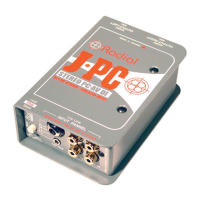True to the Music
Radial Engineering JPC User Guide
9
FAQs
Can I use the Radial JPC like a regular DI box for instruments?
Although the Radial JPC was designed to work with computer sound cards and other consumer level hi-impedance devices, it
can also be used with active instruments such as acoustic guitars that have built-in pick-up pre-amplifiers with internal
batteries. We do not however recommend using the JPC with passive instruments like a bass guitar, as the input
transformers low impedance may introduce some loading due to the impedance mismatch.
Will it then harm the JPC if I connect a bass to it?
No of course not. We only state this advisory as we make DIs for instruments such as the J48 and JDI that are simply better
for instruments. The JPC will certainly work in a pinch.
Can I use the JPC on keyboards?
Yes. Just make sure you do not overload the JPC by driving too much signal through it. The JPC’s smaller transformers are
designed for consumer type levels and keyboards, samplers and drum machines are usually much more dynamic and
uncompressed. The JDI, the Duplex, and JD6 are better suited for this.
What is the difference between the JPC and the JDI Duplex?
The Radial Duplex employs larger and much more expensive Jensen transformers to allow any instrument to be connected
without fear of saturation. The JPC uses smaller transformers and an active drive circuit that has been optimized for sound
tracks from CD’s or computers. These are generally ‘mastered’ and compressed while instrument sources are not. The
JPC’s input impedance is also lower to properly match devices like computer sound cards while the Duplex has a higher input
impedance to reduce loading with high impedance instruments. The JPC is also half the price!
What is the advantage of transformer isolating the inputs?
When any two pieces of electrically powered equipment are connected together, they form a circuit. Most often, the reference
voltages from each device differ, causing stray voltage to appear at the connections, which in turn can cause system noise
commonly known as ground loops. By isolating the inputs through a transformer, we are in fact using a magnetic bridge thus
eliminating any opportunity for ground loops in the system.
Why is there no ground lift switch?
Because the inputs are already 100% isolated, there is no input to output ground connection to break. Therefore, no ground
lift switch.

